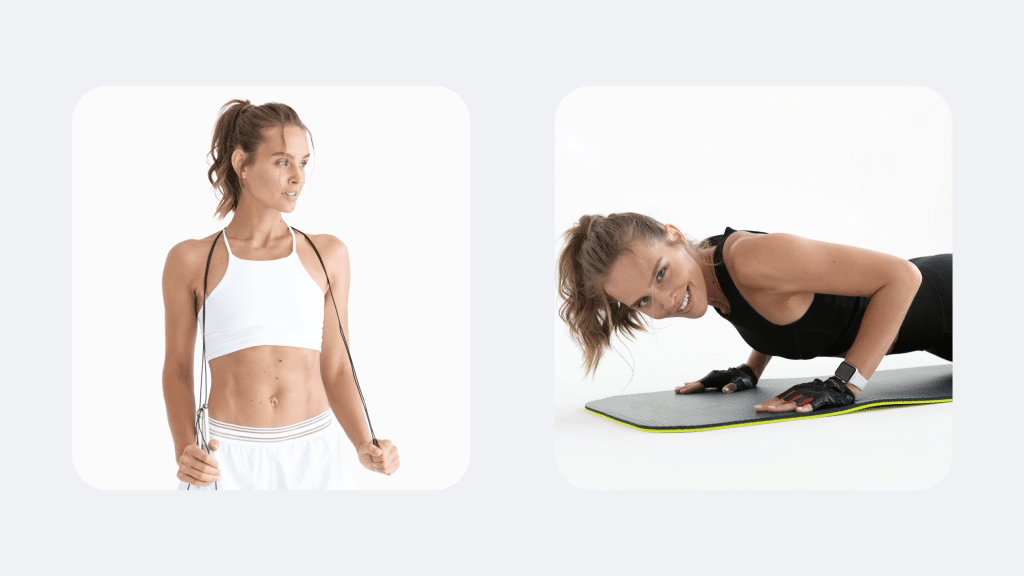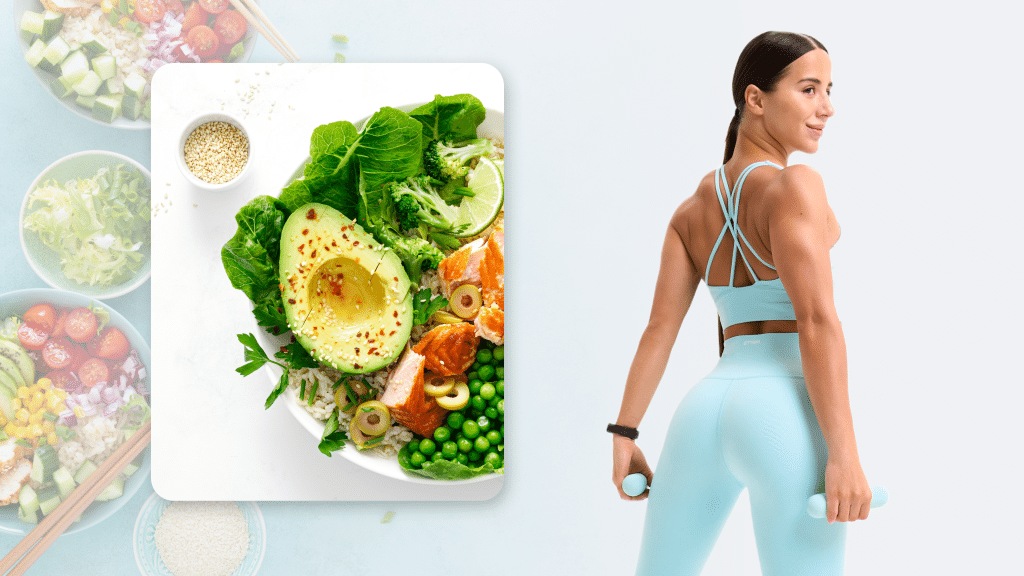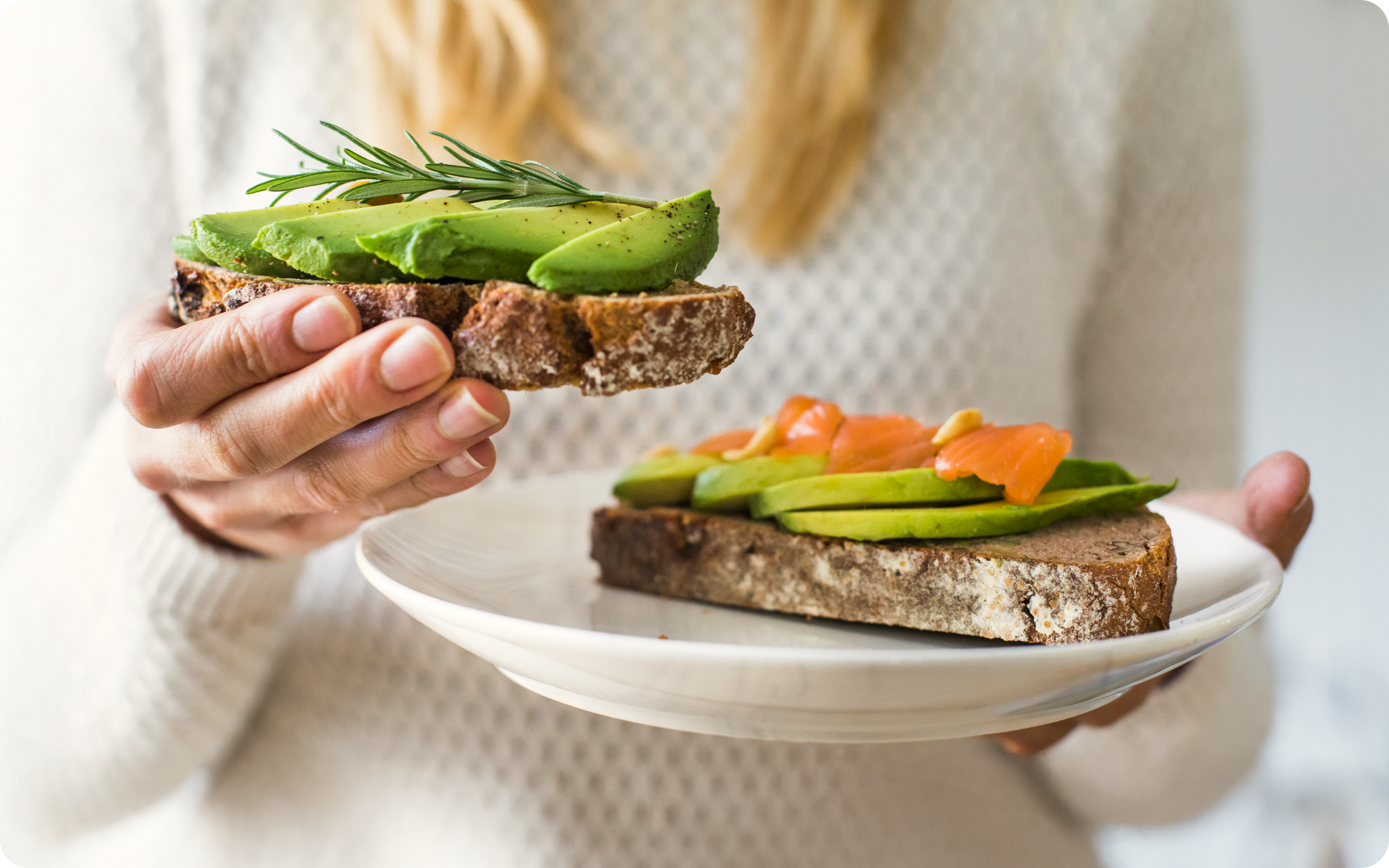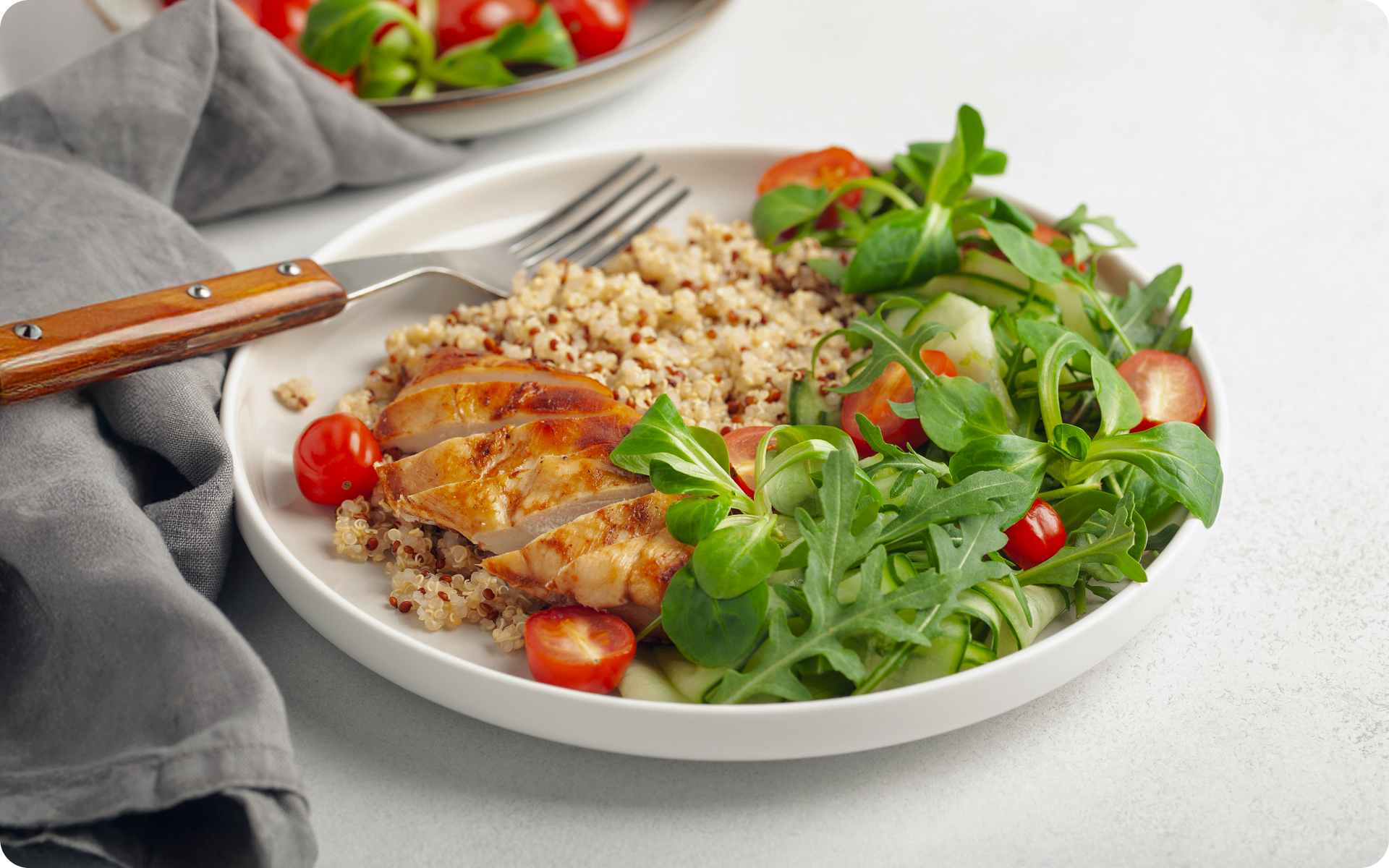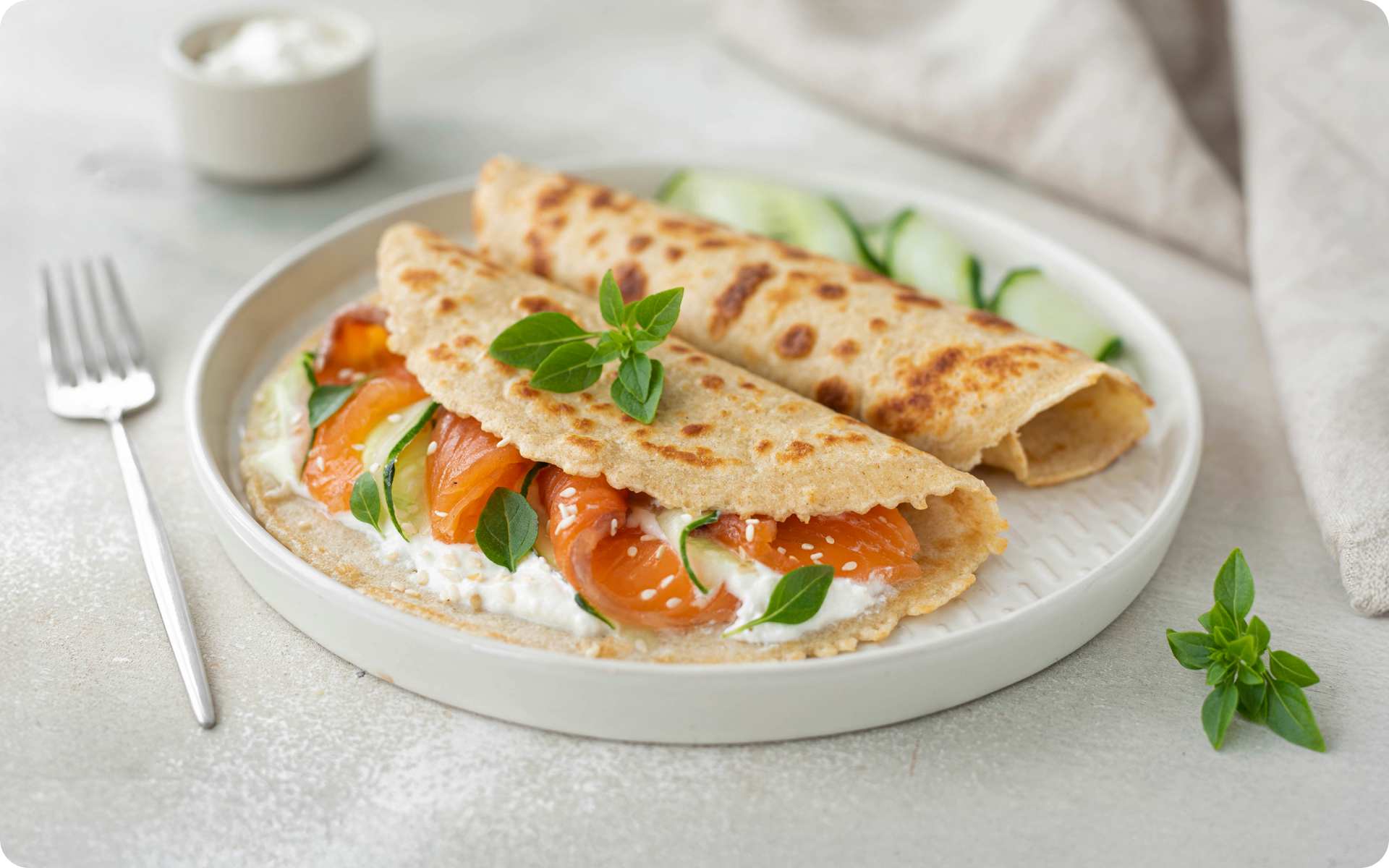Good nutrition is one of the most important ways to stay healthy. With that in mind, it’s no surprise that people are always looking for new ways to maintain a healthy diet. There are all sorts of diets out there—low-carbohydrate, low-fat, paleo, and vegan, to name a few.
However, if you’re interested in weight loss and maintaining your current lifestyle without major changes or restrictions, then calorie-deficit meals are what you need.
To lose weight, you need to eat fewer calories, plain and simple. In this article, we’ll provide you with insights into how calories work, what a deficit is, how to create one, and some meal ideas for a weight-loss diet.
What Is a Calorie?
A calorie is a unit of measurement of the energy that is provided by the foods and drinks we consume.
This energy allows our bodies to function, keeping us alive, and also allows us to complete all our daily activities. It is also the energy we use to exercise or accomplish physical tasks.
A point to note is that while everything we consume gives us calories, some foods and beverages are more dense in calories than others – that is, they provide more energy per serving size as compared to their counterparts.
How Does This Affect My Weight Loss?
Calorie intake has always gone hand in hand with weight gain, loss, and maintenance. But how does this work?
If you eat too many calories without burning enough through normal daily activities and exercise, then even if they come from healthy food sources, you’ll likely gain weight over time. This is known as a calorie surplus.
If you eat as many calories in a day as your body burns, you should end up maintaining your current weight. This is simply known as calorie maintenance.
If you eat fewer calories than your body burns, you’re likely to lose weight over time. On the other hand, if you eat too few calories, your body may go into starvation mode and your metabolism may slow down (7). This means it will be harder for you to lose weight and maintain your current weight after reaching your goal.
What Is a Calorie Deficit?
To successfully lose weight and keep it off, you need to find a calorie level that is both healthy and reasonable – this is where a calorie deficit comes in. A calorie deficit is a state where a person doesn’t consume as many calories as they burn in a day. or rather, they consume fewer calories than their body needs to maintain their current weight.
When you eat less than your body burns/needs to maintain its daily functions, it is forced to turn to its fat stores, which it then burns to use as energy. The longer you stay in a deficit, the more your body uses up its stored fat and at the end of the day, less body fat usually results in less overall body weight.
Reasons why BetterMe is a safe bet: a wide range of calorie-blasting workouts, finger-licking recipes, 24/7 support, challenges that’ll keep you on your best game, and that just scratches the surface! Start using our app and watch the magic happen.
How Do I Know My Ideal Calorie Deficit?
There are three main ways to do this:
Manual calculation
To do this, you need to start by finding out how many calories you need each day to maintain your current weight. You can roughly estimate this with a simple equation: take your current weight (in lbs) and multiply it by 15. This number represents the approximate number of calories your body needs every single day just to keep you from losing or gaining weight.
For example, if you weigh 150 lbs, you would need approximately 2,250 calories every day to maintain your weight. You can get a more accurate estimate using the Harris-Benedict equation plus an activity factor or use an online calculator that does the math for you. Now that you know how many calories your body needs to maintain its current weight, you can add or subtract from this number depending on your goals.
To lose weight, you need to eat fewer calories. Usually, subtracting 500 calories from your maintenance calorie needs is a good place to start. A healthy meal plan for weight loss could be based on approximately 1,500 calories per day if you’re a woman or 1,800 if you’re a man (3). This should be a moderate reduction from what your body needs to maintain its current weight. Remember that you need enough energy for your body’s basic functions as well as regular exercise and activity.
Use an online calorie calculator
If the above method seems too complicated, you could try using an online calorie calculator. This is the option that many use because it’s rather easy and it also tends to give you a more precise idea of how many calories are right for your specific situation.
In addition, it may give general recommendations on the types of foods that are appropriate at each calorie level. You can enter information about yourself, such as sex, height, weight, and age into this type of calculator, then click “calculate” to see an estimate.
Use a calorie counting app
While most people use such apps to track their daily food/calorie intake, they can also help you figure out how much your calorie deficit should be. They generally work in the same way as online calorie calculators and require you to input your sex, height, current weight (sometimes your new weight goal too), age, and daily activity level for them to give you your deficit.
The added benefit of such apps is that through the logging of your daily intake of food and drink, they help you track how many calories you’re eating, which lets you know if you’re maintaining the deficit or not. You can also track your daily physical exercise, which helps with weight and fat loss.
While everyone’s body has different nutritional needs, most people do best when they eat a balanced diet of a variety of healthy foods that remain within their calorie allowance.
Read more: Thigh Workout Guide: 7 Effective Exercises for Building Leg Strength
What Are Calorie Deficit Meals?
Calorie deficit meals are recipes that are designed to help you eat fewer calories than usual, so you can lose weight or maintain your current weight more easily.
To do this, the recipes have certain things in common (10):
- They will be low-calorie. The calorie content for each recipe will be lower than average. In this way, if you choose one of these recipes as part of a calorie deficit plan, then even adding small side dishes or snacks won’t push you over your calorie goal for the day.
- They won’t require a long list of ingredients or complex cooking skills. Eating a calorie deficit diet doesn’t mean you need to spend hours in the kitchen. The recipes will use simple, easy-to-find ingredients, and most will require minimal preparation time.
- They will be healthy and nutritious. Most diets that promise quick weight loss use unhealthy filler foods to reduce calories while sacrificing nutrition. We’ll teach you how to eat fewer calories without skimping on the nutrients you need.
- They will be tasty. Healthy, tasty recipes are an important part of any diet plan. You shouldn’t have to give up the flavor just because you’re trying to lose weight.
Calorie Deficit Breakfast Meals
Many diets recommend eating a small breakfast, but don’t provide many suggestions for what to eat. This can be frustrating if you’re trying to lose weight as it’s easy to get bored of the same thing every day.
As part of your diet plan, try the following breakfast recipes:
Spiced Apple Oats with Honey (2)
Apples and oats provide fiber, which can help keep you feeling full until lunchtime. This recipe also requires minimal preparation time, so it can be made before you head out the door in the morning!
Ingredients:
- 1 cup water
- 2 cups rolled oats
- Pinch of salt
- 3 apples, peeled and chopped
- 1 small cup of pecans
- Spices: 1 teaspoon cinnamon, and 1 tablespoon nutmeg
Instructions:
- Add the water to a medium pot and bring to the boil. Throw in the oats, salt, cinnamon, and nutmeg, then stir well.
- Add the chopped apples and reduce the heat. Allow to simmer for 10-12 minutes.
- Once the apples are tender, add the honey and pecans and stir.
- Turn off the heat and allow it to stand for 5 minutes.
This makes 1 serving. Calories: 262. Fats: 7 g. Protein: 6 g. Carbs: 46 g
This recipe is courtesy of healthyfitnessmeals.com.
Baked Egg Muffins with Spinach (13)
These healthy egg muffins are high-protein and low-fat, which is essential for a healthy diet. They can be eaten hot or cold for breakfast or dinner, so it’s easy to have them as part of your calorie deficit plan.
Ingredients:
- Cooking spray
- 4-ounce carton liquid egg white
- 6 ounces shredded reduced-fat sharp cheddar cheese
- 10-ounce package frozen chopped spinach, thawed and drained
- 1 teaspoon hot sauce
- 1 teaspoon salt
- ½ teaspoon ground black pepper
Instructions:
- Preheat the oven to 350 degrees F. Next, spray a muffin tin with the cooking spray.
- Mix all the ingredients in a bowl. Ladle the mixture into the muffin tin, only filling to ¾ full.
- Bake in the oven for 20-25 minutes. Serve warm or cold.
This makes 10 servings. Calories for 1 serving: 59. Fats: 2 g. Protein: 8 g. Carbs: 2 g
This recipe is courtesy of allrecipes.com.
BetterMe app will provide you with a host of fat-frying fitness routines that’ll scare the extra pounds away and turn your body into a masterpiece! Get your life moving in the right direction with BetterMe!
Garden Vegetable Frittata (8)
At less than 200 calories per serving (and with almost 30 grams of protein), you won’t find a more nutrient-dense and filling recipe. This is the perfect dish for people who eat fewer than 500 calories at breakfast as it will help keep you feeling full all morning.
Ingredients:
- 6 eggs, beaten
- ⅓ cup milk
- 1 tablespoon fresh chives, chopped
- 1 teaspoon fresh marjoram, chopped
- ½ teaspoon salt
- ⅓ cup onion, chopped
- 1 small zucchini, halved lengthwise and sliced
- 1 garlic clove, minced
- 1 cup frozen corn
- 2 cups fresh small broccoli florets
- 2 teaspoons oil
- ½ cup shredded cheddar cheese
- 2 Italian plum tomatoes, thinly sliced
Instructions:
- Mix the first five ingredients well in a bowl and set them aside.
- Heat the oil (1 teaspoon) in a 12-inch non-stick skillet on medium-high heat until hot.
- Add the zucchini, garlic, and onion; cook and stir for a minute. Reduce the heat to medium and throw in the broccoli, corn, and water. Cover and allow to cook for 4-6 minutes.
- Remove the vegetables from the skillet. Add 2 teaspoons of oil to the skillet. Return the vegetables and pour the egg mixture over them. Cover loosely and allow to cook for 10-15 minutes.
- Sprinkle the frittata with cheese and arrange the tomato slices on the top. Cook for 1-2 minutes and garnish if desired. Cut into wedges and serve.
Calories for 1 serving: 290. Fats: 16 g. Protein: 14 g. Carbs: 6 g
This recipe is courtesy of bettycrocker.com.
Calorie Deficit Lunch Recipes
Many diets recommend skipping lunch, but this isn’t practical or fair to your body. After not eating anything all night and then burning up some energy first thing in the morning, you need to refuel around midday.
Instead, try the following healthy recipes for your mid-day meal:
Vegetable Soup (12)
Whether you use it as a light pre-lunch or fill it up with rice, this low-calorie vegetable soup is high in fiber and nutrients. It also doesn’t require any cooking skills!
Ingredients:
- 14-ounce can chicken broth
- 11.5-ounce can tomato-vegetable juice cocktail
- 1 cup water
- 1 large potato, diced
- 2 carrots, sliced
- 2 stalks celery, diced
- 1 cup chopped fresh green beans
- 1 cup fresh corn kernels
- Salt and pepper to taste
- Creole to taste
Instructions:
- Combine all the ingredients in a large stockpot and season.
- Boil the mixture and simmer for 30 minutes.
This makes 6 servings. Calories for 1 serving: 116. Fats: 1 g. Protein: 4 g. Carbs: 24 g
This recipe is courtesy of allrecipes.com.
Mushroom and Mint Salad (11)
This is filled with low-calorie, nutrient-dense ingredients (mushrooms are full of B vitamins), but is still tasty enough to make you feel as if you’re eating something special. You’ll feel full without piling on the calories.
Ingredients:
- 16 medium white or cremini mushrooms, trimmed and very thinly sliced
- ¼ cup extra virgin oil
- 1 tablespoon plus 1 teaspoon fresh lemon juice
- Salt and freshly ground pepper
- Finely grated zest of 1 small lemon
- ¼ cup thinly sliced mint leaves
Instructions:
- Arrange the mushrooms on a platter, then drizzle them with lemon juice and olive oil. Season using salt and pepper.
- Scatter the mint and lemon zest over the mushroom and serve.
The above recipe makes 6 servings and is courtesy of foodandwine.com.
Chicken Enchiladas (6)
We’ve swapped out tortillas for lettuce leaves to create a lower-calorie version of chicken enchiladas that’s ideal for a calorie deficit diet. What makes this recipe great is that it can be made in advance and reheated for quick lunches during the week.
Ingredients:
- 10 ounces enchilada sauce
- 4 ounces cream cheese
- 1 ½ cups salsa
- 2 cups cubed cooked chicken
- 15 ounces pinto beans, rinsed and drained
- 4 ounces chopped green chilies
- Lettuce leaves
- 1 cup shredded Mexican cheese blend
Instructions:
- Spoon the enchilada sauce into a greased baking dish.
- Cook and stir the cream cheese and salsa for approximately 2 minutes on medium heat in a large saucepan until blended. Stir in the beans, chilies, and chicken.
- Place approximately ⅓ cup of the chicken mixture in the center of each lettuce leaf. Roll up and place the seam side down over the sauce.
- Top with the remaining enchilada sauce, then sprinkle with cheese.
- Cover and bake for approximately 25-30 minutes at 350 degrees F.
This makes 2 enchiladas. Calories for 1 enchilada: 468. Fats: 13 g. Protein: 34 g. Carbs: 51 g
This recipe is courtesy of tasteofhome.com.
Read more: 1,200 Calorie Deficit: Is It a Safe Way To Lose Weight?
Calorie Deficit Dinner Recipes
As you lose weight, you may find yourself struggling to make healthy food choices at dinner time. This is particularly true if you’ve been eating large portions of high-calorie foods throughout the day.
To help keep your daily calorie intake on target, try the following recipes:
Lemon Chicken Stir-Fry (9)
One of the best things about stir-fry dishes is how easy they are to prepare. You can just throw everything into one frying pan for an instant meal with no complicated steps or cooking skills required. In addition, this dish provides over 20 grams of protein per serving, so you won’t be hungry again an hour later.
Ingredients:
- 2 tablespoons extra-virgin oil
- ½ onion, finely chopped
- 3 garlic cloves, minced
- 2 pounds skinless, boneless chicken breasts, cut into ¾-inch pieces
- 1 tablespoon soy sauce
- ¼ teaspoon toasted sesame oil
- Kosher salt
- Freshly ground pepper
- 1 tablespoon and 1 teaspoon finely grated lemon zest
- 2 tablespoons fresh lemon juice
- 1 scallion, thinly sliced
- Steamed rice
Instructions:
- Heat the olive oil in a large skillet and cook over moderate heat for 4 minutes until softened. Add the garlic and cook for a minute.
- Throw in the chicken and cook for 3 minutes over moderate heat until browned.
- Add the soy sauce and sesame oil. Season with salt and pepper and stir-fry for 3 minutes more until the chicken is cooked through.
- Remove from the heat and add the lemon zest and juice. Season and transfer the chicken to a platter.
- Top with sliced scallions and serve with rice.
This recipe makes 4 servings and is courtesy of foodandwine.com.
Citrus Chicken and Kale Salad (5)
This healthy salad is full of antioxidants, tastes great, and is easy to make. You could even prepare everything in advance, so it’s ready to eat when you need it (just add the kale right before you eat). This recipe also contains less than 50% calories from fat, making it perfect for people who are watching their diet.
Ingredients:
For the chicken:
- 2 medium-sized chicken breasts
- 2 tablespoons olive oil
- 1 tablespoon adobo seasoning
For the salad:
- 4 cups firmly-packed shredded kale
- 2 cups broccoli slaw
- 2 cups finely shredded Brussels sprouts
- ½ cup dried cranberries
- ¼ cup sunflower seeds
For the dressing:
- ⅓ cup extra-virgin oil
- ¼ cup freshly squeezed orange juice
- 1 tablespoon freshly squeezed lime and lemon juice
- 3 teaspoons honey
- ¼ teaspoon kosher salt
- 1 ½ teaspoon poppy seeds
Instructions:
For the chicken:
- Preheat the oven to 375 degrees F.
- Coat the chicken in adobo seasoning and olive oil.
- Wrap the chicken in a foil until the digital thermometer reads 170 degrees.
- Remove from the oven and allow to rest for 10 minutes. Chop into 2-inch chunks.
For the dressing:
- Mix all the ingredients well together in a small bowl.
For the salad:
- Combine the salad ingredients and toss gently until mixed well.
- Drizzle with dressing while tossing and add the chicken. Serve immediately.
This makes 1 serving. Calories: 381. Fats: 22 g. Protein: 17 g. Carbs: 34 g
This recipe is courtesy of sweetdesigns.com.
Mixed Bean Stew with Beetroot (3)
Low-calorie and filling, this dish can be eaten as a side or main course. It contains less than 45 grams of carbs per serving and has over 20 grams of fiber, which will keep your digestive system happy too.
Ingredients:
- 2 tablespoons olive oil
- 1 medium onion, sliced
- 3 medium beets and carrots, grated
- 1 yellow bell pepper, cored and chopped
- 4 medium tomatoes, chopped
- 4 cups vegetable stock
- 5 cups water
- 1 can black beans, drained and rinsed
- 1 teaspoon garlic powder
- Sea salt and pepper to taste
- ¼ lemon
- 2 handfuls chopped parsley
Instructions:
- Heat the olive oil over medium heat in a large pot, then add and cook the onions for approximately 4 minutes.
- Throw in the carrots, bell pepper, beets, and tomatoes. Cover and cook for 5-7 minutes, stirring occasionally until the vegetables start to soften.
- Add the water, black beans, vegetable stock, garlic powder, and season with salt and pepper. Bring to the boil and reduce the heat. Cover and allow to cook for approximately 10 minutes.
- Squeeze in the lemon juice and also drop the lemon in the soup. Add the parsley and continue cooking for 2-3 minutes. Turn off the heat and serve.
This recipe makes 6 servings. Calories for 1 serving: 168. Fats: 5.2 g. Protein: 6.7 g. Carbs: 26.1 g
This recipe is courtesy of mariaushakova.com.
FAQs
Will I lose weight on 1,500 calories a day?
Yes, you can.
According to an article in the National Library of Medicine, the average calorie needs for the average woman and man is 2,000 kcal and 2,500 kcal respectively per day. This means that an intake of 1,500 kcal would count as a calorie deficit meal plan, which should lead to weight loss over time (4). However, to ensure this is your recommended deficit intake per day, please make sure to use any of the above calorie deficit counting methods to determine a more individualized goal.
Is 2 meals a day a calorie deficit?
It depends on how many calories you eat in those two meals.
For example, if your recommended calorie intake to create a deficit is 1,500 kcal and you consume 750 kcal for each of the two meals, then yes, eating two meals a day can lead to a deficit. However, if you’re eating 1,000 calories for each meal, then having just two meals a day may not count as a deficit, depending on your energy expenditure.
You may have reduced the number of times you eat a day, but you haven’t reduced the amount of calories. A calorie deficit is the reduction of calories consumed a day, not necessarily the number of times you eat. You can eat 6 meals a day and still be in a deficit, or you can eat 2 meals and not be. The trick is to make sure all the meals together stay within your overall calorie target.
Can I eat only 1 meal a day?
Some people can, but it’s not without risks. Eating one meal a day, which is also known as OMAD, is an extreme version of intermittent fasting. With this variation, people fast for 23 hours and only allow themselves 1 hour to consume all the calories they need for a day.
As the eating window is quite small, people often have to eat one huge meal all at once in an effort to consume all the required calories for the day. While some can manage this, most people cannot, which leads to undereating and as mentioned above, this can make weight loss even harder.
To reach their calorie intake for the day, some people rely on unhealthy fatty foods. While this could seem like a fun and tasty loophole, research has suggested that doing so could lead to an increase in blood pressure and cholesterol (1).
Eating only once a day also comes with potential side effects such as:
- Feelings of extreme hunger, which could lead to binge eating
- Shakiness or physical weakness
- Fatigue and low energy
- Brain fog and trouble focusing
While some swear by the benefits of OMAD, we suggest trying other variations of intermittent fasting such as 16/8, 14/10, or 18/6.
Should I skip meals for calorie deficit?
No, you shouldn’t.
As explained above, being in a deficit simply means reducing what’s on your plate, not necessarily reducing the amount of times you eat in a day. One study published in 2020 stated that while skipping a meal can help reduce daily calorie intake, it also reduces daily diet nutrition quality and could impact health negatively over time (14).
Skipping meals could also lead to a slower metabolism, which means that your body burns calories slower. leading to slower weight loss and eventually fat gain over time. It also leaves you with very little energy, which could make you feel weak and sluggish.
Should I do a 3-day juice cleanse for a calorie deficit?
No, you shouldn’t.
While a juice cleanse may look like a calorie deficit, it’s usually simply just undereating. Undereating can lead to health risks such as osteoporosis and bone fractures, infertility, developmental problems in children, a weakened immune system, malnutrition, increased risk of surgical complications, anemia, and chronic fatigue.
Instead of trying a 3-day juice cleanse, use the same fruits and vegetables to make healthy weight loss meals instead. Fill half your plate with fruits and vegetables, a quarter with lean protein, and the other quarter with complex carbohydrates from whole grains or starchy vegetables.
What are the benefits of fruit fasting?
The purported benefits of fruit fasting include:
- Creating a calorie deficit
- Weight loss
- Appetite regulation and increased satiety
- Increased intake of antioxidants
- System flush
While these alleged benefits may make you want to try such a diet, we advise against it.
Yes, eating only fruits for a couple of days may increase the amount of antioxidants you’re eating, but fruits have no proteins and a large number of them have little or no fat content. Doing this eliminates some major food groups from your diet, which is not healthy.
Consuming only fruits may create a calorie deficit, but you’ll most likely be undereating, which is really not a good health or weight loss option. Finally, you don’t need to go the extra step to detoxify or flush your body of so-called toxins. Your body already has a system set up to naturally do this through the kidneys, liver, lungs, intestines, and skin.
Yes, eating well may help improve the function of these organs, but you don’t need to go on a whole separate diet for this. As long as you’re healthy, eating a healthy balanced diet will keep these organs in tip-top condition where they can easily get rid of any toxins.
The Bottom Line
Nobody likes to count calories or think about what they can or can’t eat, which is why it’s important to have a list of healthy meals you don’t need to think too much about. These recipes offer all the nutrients your body needs without piling on the pounds. They’re also easy enough for anyone to make, no matter how little cooking experience you have.
DISCLAIMER:
This article is intended for general informational purposes only and does not serve to address individual circumstances. It is not a substitute for professional advice or help and should not be relied on for making any kind of decision-making. Any action taken as a direct or indirect result of the information in this article is entirely at your own risk and is your sole responsibility.
BetterMe, its content staff, and its medical advisors accept no responsibility for inaccuracies, errors, misstatements, inconsistencies, or omissions and specifically disclaim any liability, loss or risk, personal, professional or otherwise, which may be incurred as a consequence, directly or indirectly, of the use and/or application of any content.
You should always seek the advice of your physician or other qualified health provider with any questions you may have regarding a medical condition or your specific situation. Never disregard professional medical advice or delay seeking it because of BetterMe content. If you suspect or think you may have a medical emergency, call your doctor.
SOURCES:
- A controlled trial of reduced meal frequency without caloric restriction in healthy, normal-weight, middle-aged adults (2007, ncbi.nlm.nih.gov)
- Apple Cinnamon Oatmeal (2021, healthyfitnessmeals.com)
- Beetroot Soup with Beans (2015, mariaushakova.com)
- Calories (2021, nih.gov)
- Citrus Kale Salad With Baked Chicken Recipe (2021, sweetdesigns.com)
- Easy Chicken Enchiladas (2021, tasteofhome.com)
- Fat loss depends on energy deficit only, independently of the method of weight loss (2007, pubmed.gov)
- Garden Veggie Frittata (2016, bettycrocker.com)
- Lemony Chicken Stir-Fry (2014, foodandwine.com)
- Low-calorie diets and sustained weight loss (2012, wiley.com)
- Mushroom Salad with Mint (2006, foodandwine.com)
- Quick and Easy Vegetable Soup (n.d., allrecipes.com)
- Spinach Egg White Muffins (n.d., allrecipies.com)
- The effects of skipping a meal on daily energy intake and diet quality (2020, ncbi.nlm.nih.gov)

